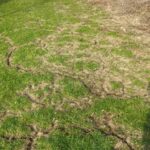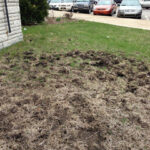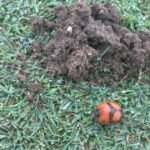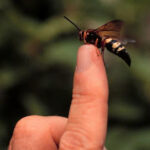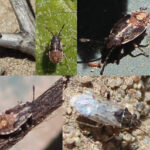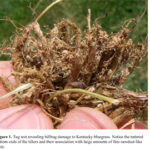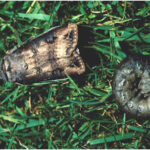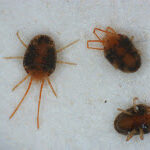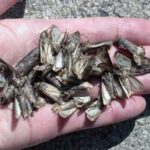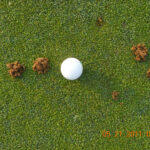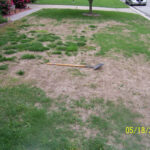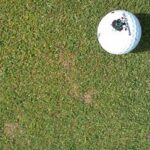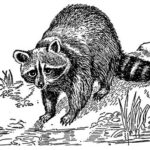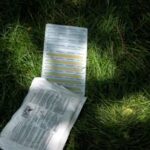Tim Gibb

Chiggers and Their Control (E-34-W)
Purdue Extension Publication
Ants (E-22-W)
Purdue Extension Publication
Melting Snow Reveals Tiny Trails
With the winter snows finally melting away many are often surprised to find a series of tiny trails on the surface of their lawns and turfgrass fields. These are vole highways. Voles are often called meadow or field mice. While they are similar to a house mouse in general size and shape, they […]
Guess Who Came to Dinner?
The photos below were submitted to our laboratory for identification. While there are no animals present in the photos, the damage depicts the problem very nicely. Even without seeing any, I am quite certain that the turf is infested with white grubs. As you know, white grubs do some damage to grasses, but what […]
When a GPS Unit Malfunctions
This photo was submitted from a golf course where it was found tunneling into a green. It is obvious that it is creating some damage but the astute manager was able to find and photograph the beetle in association with the damage. This combination always makes identification and control recommendations much easier. The insect was […]
Cicada killers are Wimps
Spread the word – Cicada killers are wimps! Unfortunately, because of their size and the fact that they often live in lawns and landscapes close to where people live, cicada killers evoke a great deal of anxiety. These wasps are huge and look very much like oversized yellow jackets but they have some very important […]
Ground Moving with Tiny Migrating Insects
Whenever I give my ‘General Insect Pest’ presentations I include a couple of photos of chinch bugs and their nymphs. Usually I say something like “These are not pests every year in Indiana but can become troublesome in years when we have a drought.” Guess what? That is now! The dry conditions we are […]
Japanese Beetle Emergence and Management
Below is an e-mail conversation that may be of benefit to other turfgrass managers asking similar questions. Original message: From: Golf Courses Date: Friday, June 22, 9:30 AM To: Gibb, Timothy “Gibb, Timothy” <gibb@purdue.edu> Subject: Japanese Beetles Management in 2012 With the early spring we expected to see early Japanese Beetles. We did […]
Purdue Annual Turfgrass Research Report
As the green industry continues to have a large impact on Indiana and the nation, Purdue University has assembled an outstanding team of researchers, extension personnel, and educators that are dedicated to solving problems and helping meet the needs of Indiana residents. One segment of the Indiana green industry that continues to provide a significant […]
Early Billbug Damage Reported Across the Midwest
This season continues to challenge our traditional thinking about insect seasonal ecology and management. Indiana and neighboring states are currently witnessing serious billbug infestations with late instar billbug larvae already present in the soil. This activity is easily 2-3 weeks ahead of normal. We advise all turf managers to take a close look at areas […]
Japanese beetle monitoring traps confirm early season in 2012
As anticipated, Japanese beetles are out early this year. The first beetles were captured in central Indiana during the week of May 14-18. (This is nearly a month earlier than most years.) We expect Japanese beetles to arrive in full force in this area within the next 2-3 weeks. Because we have never experienced […]
Black Cutworm and Armyworm Moths Are Early Arrivals in 2012
The mild winter experienced throughout the midwest has affected the arrival of our early season moths. Recent reports of both armyworm and black cutworm adults throughout the state signal an early arrival of the caterpillars. The first order of business for these moths is to mate and lay eggs. Golf course superintendents and athletic field […]
2012 = Same Pests But Earlier ETA
With the very mild winter that most of Indiana experienced so far, we are being asked about its effect on insect populations for this year. The consensus among turfgrass entomologists is that although insect populations were probably not especially hurt by low temperatures this winter, they probably have not benefitted that much either. Insect pests […]
Warning: High Numbers of Black Cutworms in Traps
June 28/11. We are reporting very high numbers of black cutworm moths in traps right now. These numbers are, in fact, higher than we have seen in many years. What this means to you is that there is a possibility that these moths will lay eggs on your turf and the resulting caterpillars may damage […]
Mound Making on Greens and Tees
In addition to earthworms, there are several insects that can create small mounds of soil above the surface of turfgrass. Usually such mounding is of minimal consequence and, in fact, is beneficial to turfgrass environments as it accomplishes the same thing as cultivation, aeration and top-dressing – only on a very small scale. On occasion, […]
The Case of the Dead Zoysia in Southern Indiana
Zoysia grass is a warm-season grass that is being more frequently used in warm, humid and transitional regions. As zoysia is becoming more frequent in our state we are learning more about the pests that attack it. The photograph below was taken of a stand of zoysia in the southern part of Indiana. It was […]
Sod webworms
Sod webworms may cause damage to closely mowed turfgrass early in the spring. Damage, similar to that depicted in the photos below, may be seen on golf tees and greens. The overwintered caterpillars become active when the temperatures warm up in the spring and begin to tunnel and feed. They are mostly active at night, […]
Small Moving Specks on the Windowsill?
No you are not imagining this. The specks are actually moving. That is because they are actually tiny mites called clover mites. Clover mites can become annoying household pests, especially in and around homes where new lawns have recently been established or where there’s a heavy growth of well-fertilized grass close to foundation walls. They […]
Skunks and Raccoons causing Havoc?
We continue to receive reports of spring-time turfgrass damage caused by raccoons or skunks. These animals are not feeding on the grass but rather are foraging for below ground, high populations of white grubs. As the vertebrates forage, they turn over great clumps of turfgrass resulting in an area that resembles a war zone. Sometimes […]
Fall Time Mole Control
Moles are back in the limelight!. These small subterranean, tunnel-making pests are causing big frustrations for those managing turfgrass and landscapes. Mole damage is most common during the spring and fall. The only two methods of effectively controlling moles are to; (1) use a bait that they are attracted to OR (2) to physically remove […]
